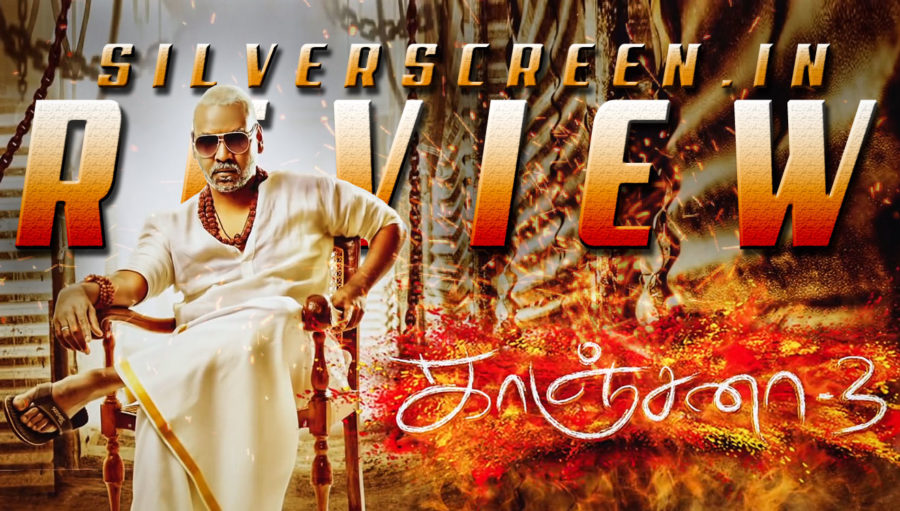Director: Raghava Lawrence
Cast: Raghava Lawrence, Oviya, Vedhika, Soori, Kovai Sarala, Delhi Ganesh
A Twitter user said not too long ago, that even after humanity dies out and a dystopian future arrives, Raghava Lawrence will still be making Kanchana films. This seems to be true. Even as the third film ended, the screen warned us to prepare for Kanchana 4/Muni 5.
And this seems to be the biggest problem writer, director and star of Kanchana 3, Raghava Lawrence, faces. How does one make a horror-comedy franchise feel fresh film after film? He started with Muni, and then brought in Kanchana – the second film that spawned its own franchise. Kanchana was a moving film over and above the horror genre. It gave us one of the most empathetic portrayals of a trans woman character in Tamil cinema, and reset expectations of Raghava Lawrence. The third film in the series though, felt a bit of a damp squib, not least because the genre – comedy-horror – saw more films and more actors, and even Lawrence moved on to make Motta Siva Ketta Siva and Shivalinga (which although horror, was also a bit of a mixed bag genre wise).
And now, we have Kanchana 3/Muni 4 and it seems like a return to the franchise’s original settings and old templates.
*****
Kanchana 3 is written and directed by Raghava Lawrence, who also stars in the film along with regulars Kovai Sarala, Devadarshini, Sriman, as well as Oviya, Delhi Ganesh, Vedhika, Soori, Kabir Duhan Singh, Anupama Kumar, and others. The film is produced by Sun Pictures’ Kalanidhi Maran, along with Raghava Lawrence. Music is by digital platform DooPaaDoo featuring different composers for each song.
*****
Kanchana 3 opens with a prologue: a brutal killing of two police officers by a group of rowdies. One of the police officers is said to be upright and honest, and with a sense of justice. We learn he was investigating a murder involving Bhavani (Kabir Duhan Singh) a rich man with a hipster beard, so of course he has to die.
Next, a want-to-be rowdy Govindan (Soori) approaches one of the killers and says he has a commission for him. In a passing reference to the Pollachi issue, Soori says a couple of men have compromising videos of a young woman, and when the woman’s father went to question the men, he was beaten up. The killers are thus lured to an empty street where the beaten-up and bandaged “father” of the woman punches, maims, electrocutes, slits throats, and otherwise inflicts grievous bodily harm to the killers of the police officers. And we realise this man is Kaali (Raghava Lawrence).
Kaali dispatches the bodies of the dead rowdies to the hipster beard, who in true Tamil cinema fashion screams the hero’s name right before being brutally killed by the hero.
And thus we go into the main film.
Two fairly rich middle-aged men discuss the daughter of one of them who seems to have a mysterious ailment. Instantly the other man says this is a case of possession by a malevolent spirit – because what else can it be in the Kanchana universe? And so some Russian exorcists are brought down to Tamil Nadu to exorcise the evil spirit from the young girl’s body. They do so, with the aid of the bible, some nails fashioned into crosses, and similar props we are familiar with from watching horror genre films. Once exorcised, the spirit is nailed to a tree.
And to this tree Raghava (Raghava) and his family, comprising regulars Kovai Sarala, Sriman, Devadarshini and others arrive. Things happen, because they have to, and Raghava the coward pulls the nails out of the tree, and thus frees the evil spirits who promptly follow Raghava and family home.
Home here is Coimbatore where the extended family has assembled. Raghava’s grandparents, uncles and aunts, and their daughters. Daughters are Oviya, Vedhika, Nikki Tamboli. Because how does one have horror-comedy-Kanchana genre films without a few song and dance sequences and a heroine who is inexplicably and undeservedly in love with the hero?
Digression: I wondered while watching the film, given Oviya, what a difference it makes who writes a character. With Anita Udeep writing Oviya as a woman who desires a man and desires other things, as a contemporary young woman, and with Raghava Lawrence writing Oviya as a woman who desires a man and things, as a contemporary young woman. Same performer, same overall character outline/arc, same motivations. But so much more different in the words we hear and the actions we see.
Hauntings begin fairly soon after – and more horror-film tropes: black clad figures hanging mid air, chairs moving on their own, doors opening and closing at night – so the family consults the friendly neighbourhood Muni priest, who prescribes certain rites to be performed to ascertain what nature of evil spirit is in the house. The family perform these rites and this only unleashes the spirits further. And they enter the body of Raghava, who we know is the favoured vessel for avenging spirits. Raghava, who now wears makeup with ease, because the franchise has demanded it, and flounces around under spiritual influence, also kills a minor villainous sidekick to the villain who mouths inanities about power and minister and fort and such.
And to explain who these evil spirits are, a flashback!
Kaali is a young man who looks old – a vitamin deficiency that has turned his hair prematurely grey. We know this because Kaali’s mother Radha (Anupama) specifically tells us this in a flashback. Radha runs an ashram for young, orphaned kids. She truly cares for her kids and the people of the kuppam, and instills in young Kaali a strong sense of right and wrong. Also in the Ashram is young, white girl Rosy, who likes, and later loves Kaali. Radha dies, Kaali becomes the saviour of the kuppam and Rosy becomes his caretaker-lover.
Into this little calm lake of peace and love, enters Bhavani. The brother of the local politician who wants to use Kaali’s organisation and its back account as a front to launder black money for his politician brother. Kaali refuses and so Bhavani’s goons beat up his proteges. Kaali seeks revenge, and thus the prologue scene we saw.
We return from the flashback to the final conflict, as Raghava, with performance boosting drugs, otherwise known as the spirit of Kaali and Rosy, takes on the evil minister who killed Kaali. But surprise. Our friendly Russian exorcists are back and they are now in the employ of the evil minister.
*****
Recommended
I couldn’t resolve in my own mind if the filmmaker – who I quite admire for his use of the mass, masala genre elements to make films that somehow represent disabled, transgender and other marginalised persons – was aware that he was making the fourth film in a franchise and that things were getting a bit cliched. And if so, is that why some of those tired humour tropes felt like a self parody: Raghava leaping on to his mother’s waist, and the digs at his own cowardliness etc. Was this parody or was this regurgitation? And at what point does representation stop being representation and become exploitation?
And, much as I do admire Raghava Lawrence’s use of the mass elements, does he really have to play Kaali? Couldn’t a different actor – (Rajkiran was the first Muni, Sarathkumar was the first Kanchana) – be better in that role?
*****
The Kanchana 3 review is a Silverscreen original article. It was not paid for or commissioned by anyone associated with the movie. Silverscreen.in and its writers do not have any commercial relationship with movies that are reviewed on the site.



